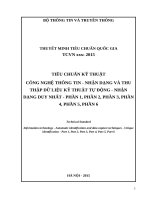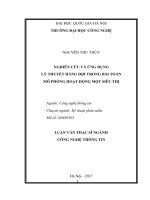Kiểm thử phần mềm trong kỹ thuật phần mềm
Bạn đang xem bản rút gọn của tài liệu. Xem và tải ngay bản đầy đủ của tài liệu tại đây (275.9 KB, 52 trang )
Software testing
Bài 11: Kiểm thử phần mềm
Objectives
•
Distinctions between validation testing and
defect testing
•
Principles of system and component testing
•
Strategies for generating system test cases
•
Essential characteristics of tool used for test
automation
Topics covered
•
System testing
•
Component testing
•
Test case design
•
Test automation
The testing process
•
Component testing
–
Testing of individual program components
–
Responsibility of the component developer
–
Tests are derived from the developer’s experience
•
System testing
–
Testing of groups of components integrated to
create a system or sub-system
–
The responsibility of an independent testing team
–
Tests are based on a system specification
Testing phases
Component
testing
System
testing
Software developer Independent testing team
Defect testing
•
The goal of defect testing is to discover
defects in programs
•
A successful defect test is a test which causes
a program to behave in an anomalous way
•
Tests show the presence not the absence of
defects
Testing process goals
•
Validation testing
–
To demonstrate that the software meets its
requirements
–
A successful test shows that the system operates as
intended
•
Defect testing
–
To discover faults or defects in the software where its
behaviour is incorrect
•
not in conformance with its specification
–
A successful test is a test that makes the system
perform incorrectly
•
Exposes a defect in the system
The software testing process
Design test
cases
Prepar e test
da ta
Run pr ogram
with test da ta
Compar e results
to test cases
Test
cases
Test
da ta
Test
results
Test
repor ts
Testing policies
•
Only exhaustive testing can show a program is
free from defects
–
However, exhaustive testing is impossible
•
Testing policies define the approach to be used in
selecting system tests:
–
All functions accessed through menus should be
tested;
–
Combinations of functions accessed through the same
menu should be tested;
–
Where user input is required, all functions must be
tested with correct and incorrect input.
System testing
•
Involves integrating components to create a
system or sub-system
•
May involve testing an increment to be
delivered to the customer
•
Two phases:
–
Integration testing - the test team have access to
the system source code. The system is tested as
components are integrated
–
Release testing - the test team test the complete
system to be delivered as a black-box
Integration testing
•
Involves building a system from its components
and testing it for problems that arise from
component interactions
•
Top-down integration
–
Develop the skeleton of the system and populate it
with components
•
Bottom-up integration
–
Integrate infrastructure components then add
functional components
•
To simplify error localisation, systems should be
incrementally integrated
Incremental integration testing
T3
T2
T1
T4
T5
A
B
C
D
T2
T1
T3
T4
A
B
C
T1
T2
T3
A
B
Test sequence 1 Test sequence 2 Test sequence 3
Testing approaches
•
Architectural validation
–
Top-down integration testing is better at discovering
errors in the system architecture
•
System demonstration
–
Top-down integration testing allows a limited
demonstration at an early stage in the development
•
Test implementation
–
Often easier with bottom-up integration testing
•
Test observation
–
Problems with both approaches
–
Extra code may be required to observe tests
Release testing
•
The process of testing a release of a system
that will be distributed to customers
•
Primary goal is to increase the supplier’s
confidence that the system meets its
requirements
•
Release testing is usually black-box or
functional testing
–
Based on the system specification only
–
Testers do not have knowledge of the system
implementation
Black-box testing
I
e
Input test da ta
O
e
Output test r esults
System
Inputs causing
anomalous
beha viour
Outputs w hich r eveal
the pr esence of
defects
Testing guidelines
•
How to reveal defects?
–
Choose inputs that force the system to generate
all error messages
–
Design inputs that cause buffers to overflow
–
Repeat the same input or input series several
times
–
Force invalid outputs to be generated
–
Force computation results to be too large or too
small
Testing scenario
A student in Scotland is studying American History and has been asked to write
a paper on ‘Frontier mentality in the American West from 1840 to 1880’. To do
this, she needs to find sources from a range of libraries. She logs on to the
LIBSYS system and uses the search facility to discover if she can access original
documents from that time. She discovers sources in various US university
libraries and downloads copies of some of these. However, for one document,
she needs to have confirmation from her university that she is a genuine
student and that use is for non-commercial purposes. The student then uses the
facility in LIBSYS that can request such permission and registers her request. If
granted, the document will be downloaded to the registered library’s server and
printed for her. She receives a message from LIBSYS telling her that she will
receive an e-mail message when the printed document is available for
collection.
A student in Scotland is studying American History and has been asked to write
a paper on ‘Frontier mentality in the American West from 1840 to 1880’. To do
this, she needs to find sources from a range of libraries. She logs on to the
LIBSYS system and uses the search facility to discover if she can access original
documents from that time. She discovers sources in various US university
libraries and downloads copies of some of these. However, for one document,
she needs to have confirmation from her university that she is a genuine
student and that use is for non-commercial purposes. The student then uses the
facility in LIBSYS that can request such permission and registers her request. If
granted, the document will be downloaded to the registered library’s server and
printed for her. She receives a message from LIBSYS telling her that she will
receive an e-mail message when the printed document is available for
collection.
System tests
1. Test the login mechanism using correct and incorrect logins to
check that valid users are accepted and invalid users are
rejected.
2. Test the search facility using different queries against known
sources to check that the search mechanism is actually finding
documents.
3. Test the system presentation facility to check that information
about documents is displayed properly.
4. Test the mechanism to request permission for downloading.
5. Test the e-mail response indicating that the downloaded
document is available.
1. Test the login mechanism using correct and incorrect logins to
check that valid users are accepted and invalid users are
rejected.
2. Test the search facility using different queries against known
sources to check that the search mechanism is actually finding
documents.
3. Test the system presentation facility to check that information
about documents is displayed properly.
4. Test the mechanism to request permission for downloading.
5. Test the e-mail response indicating that the downloaded
document is available.
Use cases
•
Use cases can be a basis for deriving the tests
for a system.
–
Help identify operations to be tested
–
Help design the required test cases
•
From an associated sequence diagram, the
inputs and outputs to be created for the tests
can be identified
Collect weather data sequence chart
:CommsController
request (repor t)
ack nowledge ()
repor t ()
summarise ()
reply (repor t)
ack nowledge ()
send (repor t)
:WeatherStation :WeatherData
Performance testing
•
Part of release testing may involve testing the
emergent properties of a system
–
Performance, reliability…
•
Performance tests usually involve planning a
series of tests where the load is steadily
increased until the system performance
becomes unacceptable
Stress testing
•
Exercises the system beyond its maximum
design load.
–
Causes defects to come to light
•
Particularly relevant to distributed systems
–
exhibit severe degradation as a network becomes
overloaded
Component testing
•
Component or unit testing is the process of
testing individual components in isolation
•
It is a defect testing process
•
Components may be:
–
Individual functions or methods within an object;
–
Object classes with several attributes and
methods;
–
Composite components with defined interfaces
used to access their functionality.
Object class testing
•
Complete test coverage of a class involves
–
Testing all operations associated with an object;
–
Setting and interrogating all object attributes;
–
Exercising the object in all possible states.
•
Inheritance makes it more difficult to design
object class tests as the information to be
tested is not localised
Interface testing
•
Objectives are to detect faults due to
interface errors or invalid assumptions about
interfaces
•
Particularly important for object-oriented
development as objects are defined by their
interfaces









